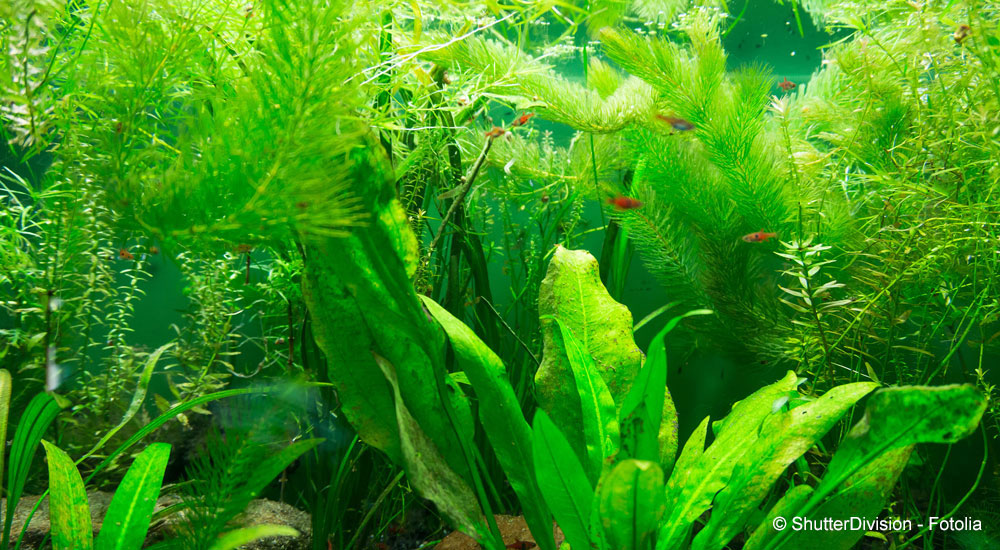Beautiful healthy aquatic plants are not just decorative features, they also perform important tasks with regards to the chemical composition of the water. To help keep your plants healthy and looking their best, we have summarised the most frequently asked questions and answers about plant care and maintenance.
How can I tell if plants are healthy when I’m buying them?
When buying aquatic plants, keep your eyes open for strong-looking plants with an abundance of leaves, none of which are brown or torn. Check for strong roots and that there isn’t any algae visible on the plants. The same logic applies to indoor plant shopping and in some cases you may find that you have to spend a little more for higher quality plants.
Do newly purchased aquatic plants need to go into quarantine?
In some cases, new aquatic plants can carry new animals into your tank including a plague of snails or freshwater polyps. When buying plants from retailers, always try to make sure that they do not come from aquariums that contain fish or snails. This will ensure you do not introduce any new animals to your tank. To avoid this, plants are also sold in plastic containers out of water and ready for planting.
Is there anything in particular that I need to consider when adding new plants?
Firstly, you should completely free the roots from the substrate in which the plants were sold. An easy way to do this is to rinse the roots under temperate, running water (a fork can be used if necessary). It is advisable to give the roots a slight trim and by doing so, the plants will establish themselves better in the new substrate making them stronger. When planting the plants, start by embedding them slightly too deeply into the substrate then pull them out slightly. Plant tweezers can come in handy for this and this enables you to ensure that the roots are pointing in the right direction and the plants are well anchored.
Which aquarium plants are fast growing?
There are several species of fast-growing aquarium plants. Just a few examples include the Southern bacopa (Bacopa australis), the green cabomba (Cabomba caroliniana), several Echinodorus species and the water snowball (Gymnocoronis spilanthoides). To find out more regarding recommended plants, including several fast-growing species, please read our article the most popular aquarium plants.
How much fertiliser do aquatic plants need?
There is no set answer to this question as the amount depends on several factors. In addition to the aquarium size, the amount of fish, other type of plants, the type of fertiliser mixed into the substrate, these should all be considered. As a general rule of thumb, you should fertilise plants on a regular basis but follow the manufacturer’s dosage instructions to avoid over-fertilisation. Ask your retailer which fertiliser is best for your aquarium plants. Another option is to use several plants that show clear signs of a lack of nutrients long before others. Hygrophila show this by developing small holes in their leaves.
Can aquarium plants catch diseases?
Discoloured or glossy leaves and other symptoms may lead you to believe that your aquarium plants are diseased. Normally though, these are not diseases in the sense that the plant has been infected by a pest, be it a fungus, bacteria or virus. Instead, the poor condition of a plant’s leaves or a lack of growth indicates that a plant is unhappy. In most cases, this is due to incorrect water parameters (temperature, pH level, hardness), poor light conditions or a lack or excess of nutrients.
Why do my plants’ leaves have holes in them?
There are various reasons why leaves may have holes in them. Some fish, such as loricarid catfish, like to eat plants. This results in ‘holey leaves’ with only their outer framework remaining. Snails can also munch holes in plant leaves. A further possibility is that the plant is suffering from a nutrient deficiency (for example nitrogen or potassium) and that certain areas of the leaf tissue are dying. In such cases, a water analysis can be used to identify the nutrient that is lacking and determine what kind of fertiliser should be added to rectify the situation.
Why are my aquarium plants turning brown?
If leaves change colour and become light green, brown or yellow, this often indicates that your plants are lacking certain nutrients. The specific colour change can depend on the plant species and the type of nutrient deficiency. For example, an iron deficiency can often be identified by new leaves having a faded colour. A lack of oxygen, on the other hand, is often identifiable on the basis of older leaves, which become brown and die. The remedy is to fertilise the plants accordingly.
The leaves on my aquatic plants look misshapen? – why?
Check the pH level in your aquarium as many aquatic plants are unable to tolerate too a high level. This impairs their ability to absorb nutrients and if the pH level in your aquarium is high, you need to change the water parameters or choose a different species of aquatic plant.
A black, slimy layer is growing on my plants – what is it?
You most likely have a blue-green algae infestation. This can be an annoying problem in aquariums and when covered in large amounts of algae, your plants’ leaves are no longer able to photosynthesise. Furthermore, blue-green algae can release toxins into the water, which can make your fish ill. Blue-green algae particularly flourish in water with too high a nutrient content or if the substrate is poorly maintained, for example too full of mulm. Proper water and substrate care should generally prevent the growth of blue-green algae. In the case of an acute infestation, it can help to leave the aquarium in complete darkness for several days. To combat the algae, try partial water changes at a higher volume and, where possible, more extensive substrate cleaning in addition to your scheduled care measures.
Why has one of my aquatic plants turned so light in colour despite the water parameters being fine?
Are you sure your aquatic plant isn’t suffering from a nutrient deficiency? If you can rule this out, there is another, relatively simple explanation: it may not be getting enough light. Different plant species have very different requirements with regard to the type and volume of light they need. Whereas some plants will cope fine with dim light, others need it to be much brighter. Ensure that your plants receive plenty of light with the right light colours and the right type of bulb. For example, fluorescent tubes need to be replaced after a certain burn time because their light colour changes over time.
Why are my tall-stem aquatic plants short and stocky?
This problem can again be caused by the wrong lighting conditions. Too much blue light can dwarf plant growth in the same way as plants that grow far too tall can be caused by too much red light. To obtain the right balance, always use special aquarium lights.

